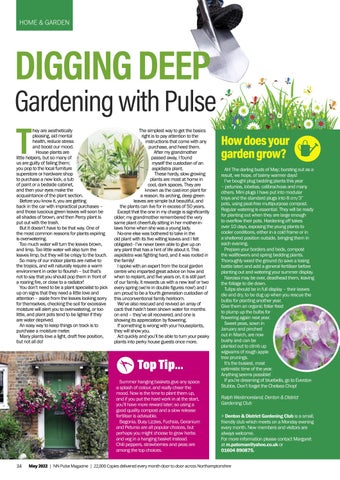HOME & GARDEN
DIGGING DEEP
Gardening with Pulse
T
hey are aesthetically pleasing, aid mental health, reduce stress and boost our mood. House plants are little helpers, but so many of us are guilty of failing them; you pop to the local furniture superstore or hardware shop to purchase a new lock, a tub of paint or a bedside cabinet, and then your eyes make the acquaintance of the plant section. Before you know it, you are getting back in the car with impractical purchases – and those luscious green leaves will soon be all shades of brown, and then Percy plant is put out with the trash. But it doesn’t have to be that way. One of the most common reasons for plants expiring is overwatering. Too much water will turn the leaves brown, and limp. Too little water will also turn the leaves limp, but they will be crispy to the touch. So many of our indoor plants are native to the tropics, and will naturally require a warm environment in order to flourish – but that’s not to say that you should pop them in front of a roaring fire, or close to a radiator! You don’t need to be a plant specialist to pick up on signs that they need a little love and attention – aside from the leaves looking sorry for themselves, checking the soil for excessive moisture will alert you to overwatering, or too little, and plant pots tend to be lighter if they are water deprived. An easy way to keep things on track is to purchase a moisture meter. Many plants love a light, draft free position, but not all do!
The simplest way to get the basics right is to pay attention to the instructions that come with any purchase, and heed them. After my grandmother passed away, I found myself the custodian of an aspidistra plant. These hardy, slow growing plants are most at home in cool, dark spaces. They are known as the cast-iron plant for a reason. Its arching, deep green leaves are simple but beautiful, and the plants can live for in excess of 50 years. Except that the one in my charge is significantly older; my grandmother remembered the very same plant cheerfully sitting in her mother-inlaws home when she was a young lady. No-one else was bothered to take in the old plant with its five wilting leaves and I felt obligated - I’ve never been able to give up on any plant that has a hint of life about it. This aspidistra was fighting hard, and it was rooted in the family! I spoke with an expert from the local garden centre who imparted great advice on how and when to replant, and five years on, it is still part of our family. It rewards us with a new leaf or two every spring (we’re in double figures now!) and I am proud to be a fourth generation custodian of this unconventional family heirloom. We’ve also rescued and revived an array of cacti that hadn’t been shown water for months on end – they’ve all recovered, and one is showing its appreciation by flowering. If something is wrong with your houseplants, they will show you. Act quickly and you’ll be able to turn your peaky plants into perky house guests once more.
Top Tip... Summer hanging baskets give any space a splash of colour, and really cheer the mood. Now is the time to plant them up, and if you put the hard work in at the start, you’ll have more reward later; so using a good quality compost and a slow release fertiliser is advisable. Begonia, Busy Lizzies, Fuchsia, Geranium and Petunia are all popular choices, but perhaps you might choose to grow herbs and veg in a hanging basket instead. Chili peppers, strawberries and peas are among the top choices. 34
How does your garden grow? Ah! The darling buds of May; bursting out as a result, we hope, of balmy warmer days! I’ve bought plug bedding plants this year – petunias, lobelias, calibrachoas and many others. Mini plugs I have put into modular trays and the standard plugs into 8 cm/3” pots, using peat-free multipurpose compost. Regular watering is essential. They will be ready for planting out when they are large enough to overflow their pots. Hardening off takes over 10 days, exposing the young plants to cooler conditions, either in a cold frame or in a sheltered position outside, bringing them in each evening. Prepare your borders and beds, compost the wallflowers and spring bedding plants. Thoroughly weed the ground (to save a losing battle later) and add a general fertiliser before planting out and watering your summer display. Narcissi may be over, deadhead them, leaving the foliage to die down. Tulips should be in full display – their leaves die and dry, to be dug up when you rescue the bulbs for planting another year. Give them an organic foliar feed to plump up the bulbs for flowering again next year. Sweet peas, sown in January and pinched out in March, are now bushy and can be planted out to climb up wigwams of rough apple tree prunings. It’s the busiest, most optimistic time of the year. Anything seems possible! If you’re dreaming of bluebells, go to Everdon Stubbs. Don’t forget the Chelsea Chop! Ralph Westmoreland, Denton & District Gardening Club > Denton & District Gardening Club is a small, friendly club which meets on a Monday evening every month. New members and visitors are always welcome. For more information please contact Margaret at m.pateman@yahoo.co.uk or 01604 890875.
May 2022 | NN Pulse Magazine | 22,000 Copies delivered every month door to door across Northamptonshire














